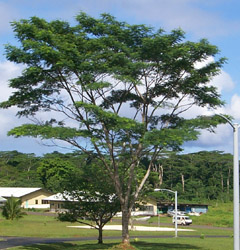The work done by Resh, Binkley, and Parrota focused on a particular family of trees that known to "fix nitrogen" in the soil. Resh, Binkley, and Parrota compared the amount of carbon the nitrogen (N) fixing trees contributed to the soil and compared this to non-nitrogen (Non-N) fixing trees. Nitrogen fixing trees include trees such as Falcataria moluccana (tuhke karisihn) and Adenanthera pavonina (kaikes, mwetkwem, red sandalwood). The non-nitrogen fixing trees in the study were Eucalptus trees. The rainbow gum tree of Mindanao with multi-colored bark that peels off (Eucalyptus deglupta) is an example of a Eucalptus tree.
The goal of Resh, Binkley, and Parrotta was to determine whether nitrogen fixing trees were able to store (sequestrate) more carbon in the soil than the non-nitrogen fixing trees. If true, then nitrogen fixing trees would remove more overall carbon from the atmosphere. This would reduce the green house effect and help slow down global warming.
The data is the gain or loss of soil organic carbon (SOC) in grams per meter squared per year for the soil associated with an individual tree. The greater the gain (positive values), the better for the purposes of this study. As this author did not have access to the original data, the following data is based very loosely on statistical information supplied in the report.


Ethnobotany class in front of Eucalyptus deglupta on field trip, Falcataria moluccana on campus
The non-nitrogen fixing tree data (Non-N) is for twenty randomly selected rainbow gum trees located in Kamar, Nett. The nitrogen fixing tree data is for twenty randomly selected Falcataria moluccana located in Palikir, Sokehs. The trees were purely randomly selected, the data is reported in the random order that the trees were selected.
Do nitrogen fixing trees store significantly more carbon in the soil than non-nitrogen fixing trees?
Use the data to generate an appropriate statistical analysis. Include numeric support for any answers you give, write any hypotheses you develop.